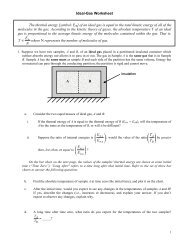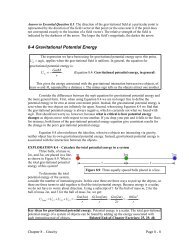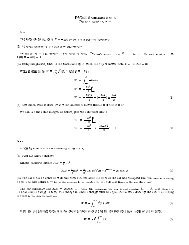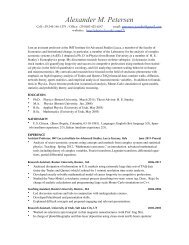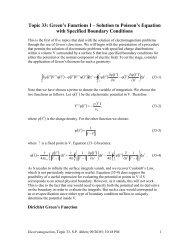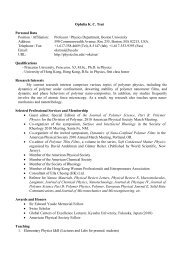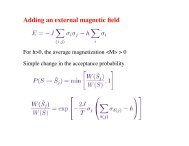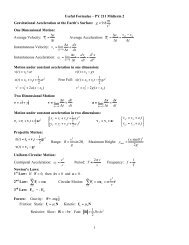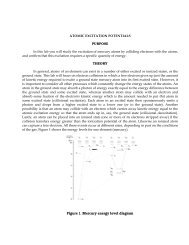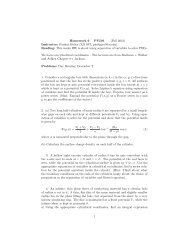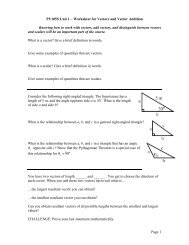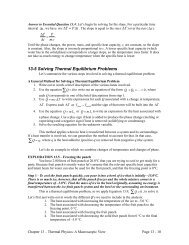Momentum, Energy, and Collisions Microcomputer-Based Lab
Momentum, Energy, and Collisions Microcomputer-Based Lab
Momentum, Energy, and Collisions Microcomputer-Based Lab
- No tags were found...
Create successful ePaper yourself
Turn your PDF publications into a flip-book with our unique Google optimized e-Paper software.
PROCEDURESimilar to how a bat navigates, the motion sensors used in the experiment measure theposition of the carts by bouncing ultrasonic waves off them. If your position graphs are notsmooth, check to see whether the motion sensors are picking up stray reflections from you orfrom other objects placed close to the track.Part I – Preliminary measurements1. Check that the motion sensor at the left end of the track is connected to the Dig/Sonic 1 porton the Vernier interface. The motion sensor at the right end should be plugged in toDig/Sonic 2. It is very important that the track is horizontal – levels are available for you tocheck this.2. You should have two different carts, one with a plunger <strong>and</strong> one without, as well as oneblack mass. Each of these items has a mass of about 500 g, but you should weigh them.3. The motion sensors have a limited range, so all collisions should take place at the center ofthe track. In collisions where one cart is initially stationary, this is easily accomplished byplacing that cart at the center of the track.4. Place the two carts at rest at the center of the track, stuck together by their Velcro bumpers.Keep your h<strong>and</strong>s clear of the carts <strong>and</strong> click . Click on All Sensors to zero bothmotion sensors. This will establish the same coordinate system for both sensors. Check thatthe zeroing was successful by clicking <strong>and</strong> rolling the still-linked carts back <strong>and</strong>forth on the track. The graphs for each motion detector should overlap for a 30-40 cm rangenear the center of the track. If not, repeat the zeroing process.QUESTION 3. Is the positive direction to the left or to the right in this experiment?5. To determine the effect of friction in the experiment, record one cart as it rolls along thetrack from left to right. To do this, click <strong>and</strong> then give the cart a push toward thecenter of the track. You should see a graph of the cart’s position as a function of time, <strong>and</strong>another showing its velocity as a function of time. The position graph will generally besmoother than the velocity graph, so we’ll use the position graph to take measurements. Tomeasure velocity from the position graph, click <strong>and</strong> drag with the mouse to select a smallregion. Click the Regression button, . A box will pop up with several checkboxes – theonly box checked should be the one corresponding to the graph you’re interested in. HitOK. The velocity of the cart is the slope of the position graph, which is the m value.QUESTION 4. Measure the cart’s velocity at two or three times separated by about 0.5 seconds.What do you observe? Is momentum conserved in this situation? Does the Law ofConservation of <strong>Momentum</strong> apply here? Explain.2 <strong>Momentum</strong>, <strong>Energy</strong>, <strong>and</strong> <strong>Collisions</strong>
Part IV – A “collision” with everything initially stationaryPlace the carts next to each other at the center of the track, with the plunger next to thecollision cart. The plunger should be armed. It’s probably better if the plunger is not all the wayin, so the carts won’t stick together with the Velcro.• Trial 6 – Equal masses. Fire off the plunger by giving the pin on top of the cart a sharp tapwith one of the black masses.• Trial 7 – Unequal masses. Place the mass on the collision cart, <strong>and</strong> repeat the experiment.Note that you can arm the plunger cart again by pushing the plunger back in <strong>and</strong> pulling up.Part V – The carts make contact but do not stick togetherFor these collisions make sure the plunger is all the way out, <strong>and</strong> facing the collision cart.• Trial 8 – Equal masses. Place one cart at rest in the center of the track, <strong>and</strong> roll the other onetowards it. The plunger should hit the collision cart (or vice versa), <strong>and</strong> the carts shouldmove separately after the collision.• Trial 9 – Unequal masses. Repeat with the black mass on one of the carts.ExtensionsIf there is time, try other collisions. Note that there is extra space in the data table. Forinstance, you could have both carts moving toward each other before the collision, or have bothcarts traveling in the same direction before the collision. These are a little trickier, because youneed to arrange it so the collision takes place close to the center of the track.QUESTIONS AND ANALYSISAfter completing the momentum <strong>and</strong> energy calculations <strong>and</strong> filling in the tables, what canyou conclude about the collisions you observed? Was momentum conserved in each collision?Was kinetic energy conserved?QUESTION 6. What are some of the possible sources of error in this experiment?QUESTION 7. Four types of collisions as described in the Theory section. What type were thecollisions you carried out in Part II with the magnetic bumpers? What about the collisions inpart III with the Velcro, the collisions where everything was initially at rest, <strong>and</strong> thecollisions in part V where the carts did not stick together afterwards?QUESTION 8. In part IV you carried out collisions in which neither cart was movingbeforeh<strong>and</strong>, <strong>and</strong> both were moving afterwards. Could you set up a collision in which thereverse happened? Explain how you could do this, <strong>and</strong> what type of collision it would be.Would momentum be conserved in this collision? You can even try it in the lab to see ifyou’re correct.4 <strong>Momentum</strong>, <strong>Energy</strong>, <strong>and</strong> <strong>Collisions</strong>
DATA SHEET — COLLISIONS TA [ ] ✍NAME:INSTRUCTOR:PARTNER: SECTION: DATE:Mass of plunger cart:_______ Mass of collision cart: _______ Extra mass:______TrialMass ofcart 1Mass ofcart 2Velocity ofcart 1beforecollisionVelocity ofcart 2beforecollisionVelocity ofcart 1 aftercollisionVelocity ofcart 2 aftercollision(kg) (kg) (m/s) (m/s) (m/s) (m/s)1 02 03 04 05 06 0 07 0 08 09 01011125 <strong>Momentum</strong>, <strong>Energy</strong>, <strong>and</strong> <strong>Collisions</strong>
Trial<strong>Momentum</strong>of cart 1beforecollision1 02 03 04 05 0<strong>Momentum</strong>of cart 2beforecollision<strong>Momentum</strong>of cart 1aftercollision<strong>Momentum</strong>of cart 2aftercollisionTotalmomentumbeforecollisionTotalmomentumaftercollision(kg•m/s) (kg•m/s) (kg•m/s) (kg•m/s) (kg•m/s) (kg•m/s)Ratio oftotalmomentumafter/before6 0 0 0 undefined7 0 0 0 undefined8 09 0101112Trial KE ofcart 1beforecollision(J)1 02 03 04 05 0KE ofcart 2beforecollision(J)KE ofcart 1aftercollision(J)KE ofcart 2aftercollision(J)Total KEbeforecollision(J)Total KEaftercollision(J)Ratio oftotal KEafter/before6 0 0 0 undefined7 0 0 0 undefined8 09 01011126 <strong>Momentum</strong>, <strong>Energy</strong>, <strong>and</strong> <strong>Collisions</strong>



![arXiv:1303.7274v2 [physics.soc-ph] 27 Aug 2013 - Boston University ...](https://img.yumpu.com/51679664/1/190x245/arxiv13037274v2-physicssoc-ph-27-aug-2013-boston-university-.jpg?quality=85)
